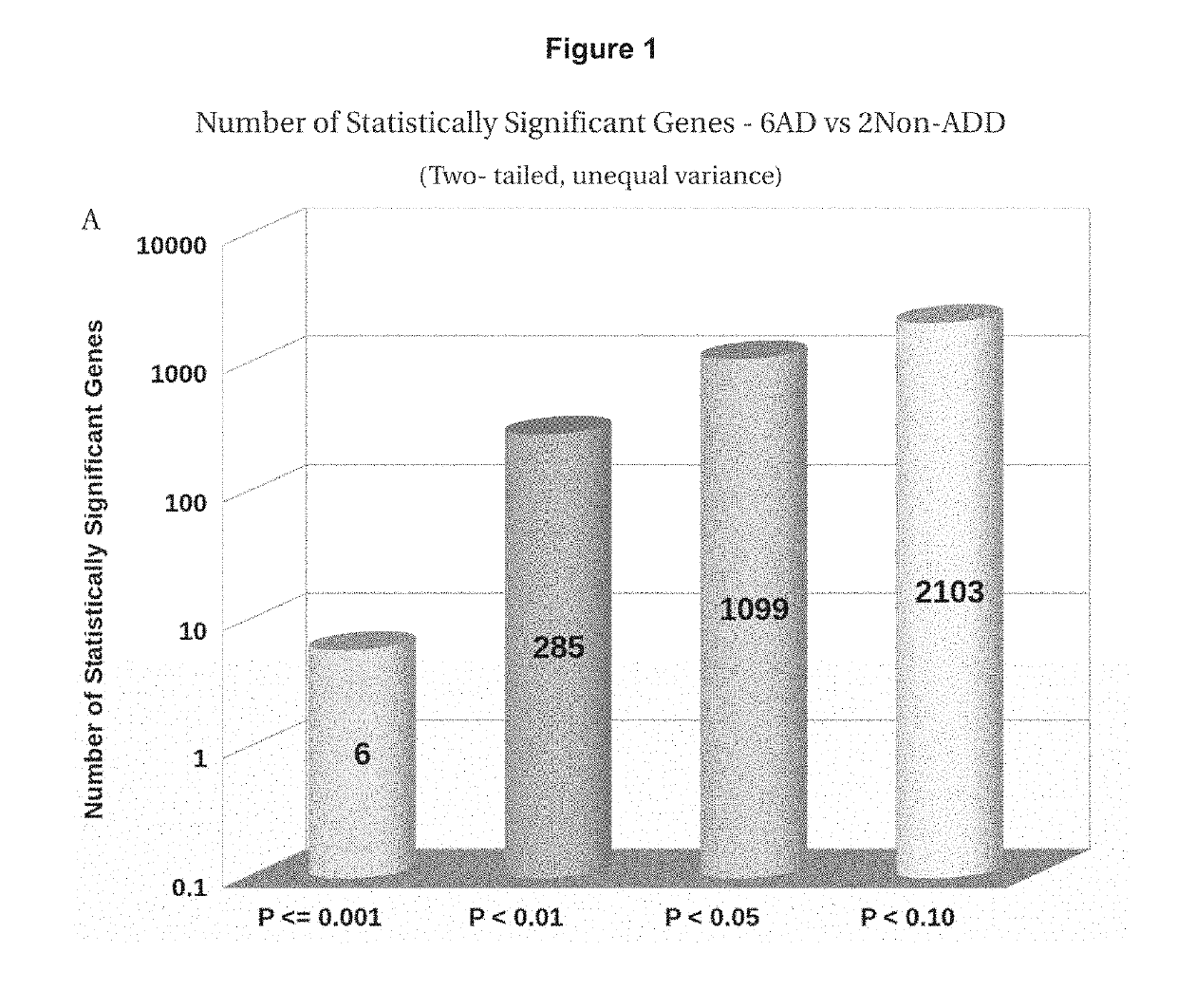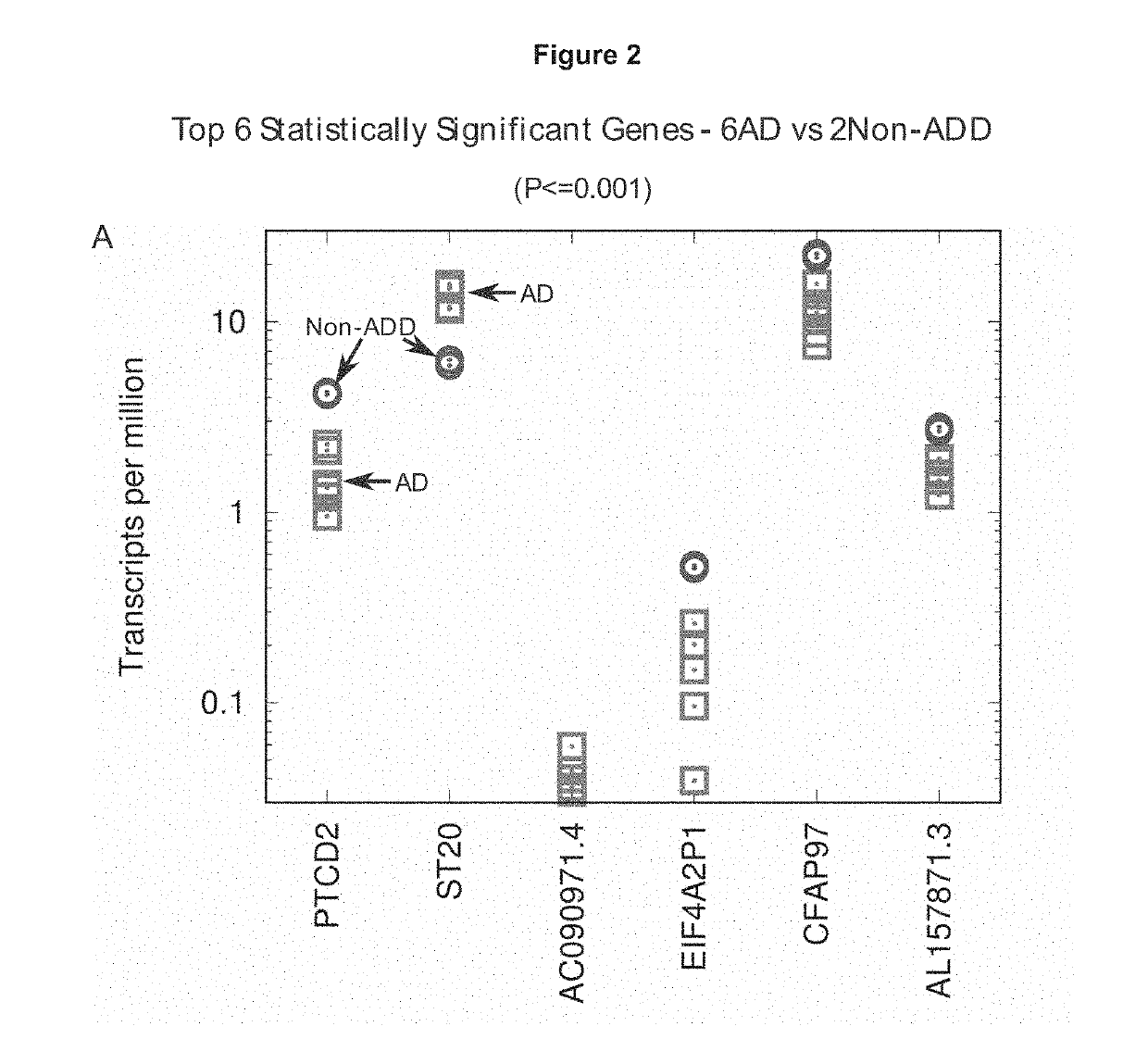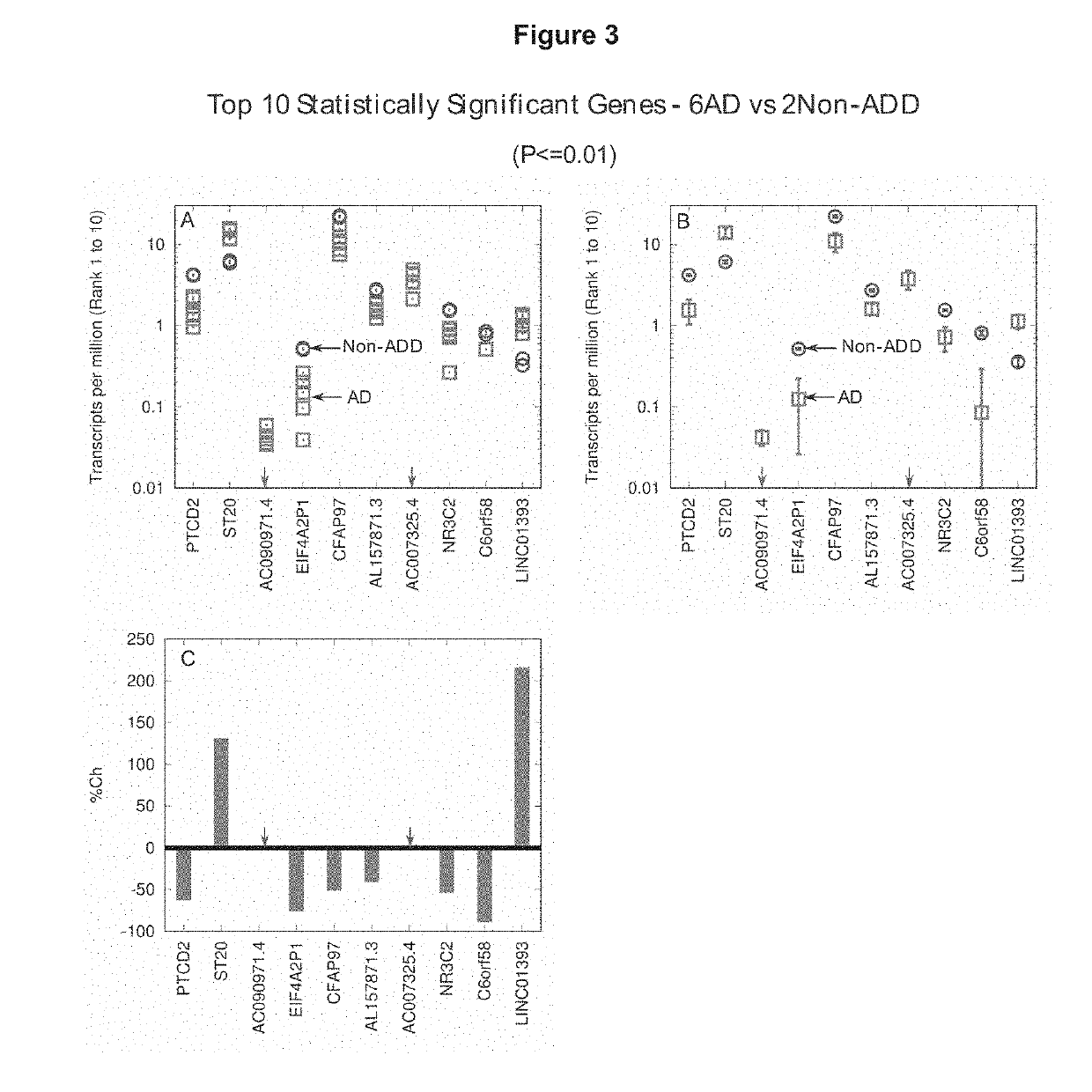Synchronized cell cycle gene expression test for alzheimer's disease and related therapeutic methods
a cell cycle and gene expression technology, applied in the direction of amide active ingredients, drug compositions, boron compound active ingredients, etc., can solve the problem of unmet need for accurate diagnosis
- Summary
- Abstract
- Description
- Claims
- Application Information
AI Technical Summary
Benefits of technology
Problems solved by technology
Method used
Image
Examples
example 1 — study 1
Example 1—Study 1
[0117]
TABLE 1Based on data from Study 1, the top 285 statistically significant genes withless than 1% overlap probability between AD and Non-ADD.Top 285 statistically significant genes with less than 1%overlap probability between AD and Non-ADDPTCD2UVSSASPIN2BIFT80PLPP5ST20KIAA1551NPM1P50AL356277.2PCSK4AC090971.4SLC43A3MIR6501FUCA1PPP1R16BEIF4A2P1BZW1P2MED26HIST1H2BLPREPLCFAP97HS6ST1P1ZNF860ZDHHC11BZNF106AL157871.3CYB561D2AC099508.1BATF2ZNF383AC007325.4SULT1A4MFN2RAET1ELEAP2NR3C2AC138623.1ASAH1TUBB2BARHGAP42C6orf58RHPN1HDAC4FOXRED2NOXRED1LINC01393ST8SIA6ZNF628AK3P3SFXN5AL031432.5TTC8C16orf62WASF2AL365203.1AC005495.1IGDCC4AC025594.2LBHD1BX322639.1NR2C2XPCADAMTSL4-AS1BEX1AC005837.1AL589684.1TDO2TESK1CNOT6LPVT1WDR17KBTBD6SFXN1ANKFY1AC073539.7FCF1P6AC004997.1JCHAINACOX2PMLAC092818.1AL592183.1F2RURAHPKDELC2FGRAC226101.1PLCB4COX7A2LAC109583.2HNRNPA3P10AC087672.3CACUL1LSSAL158835.2C17orf97FOXN3KRT8P33LINC02126AL591846.2FAM13AKANK2IMPDH1P4AL049840.5DHRS4L2ARMCX5-GPRASP2ZNF1...
example 2 — study 2
Example 2—Study 2; Synchronized Cell Cycle Gene Expression Test for Alzheimer's Disease; Cross-Validation of Genetic Differential Expression
[0118]The initial findings of the gene differential expression in synchronized skin fibroblasts, between the Alzheimer's Disease patients (AD; n=6) and the Non-Alzheimer's Disease Demented patients (Non-ADD; n=2), were cross-correlated with the second batch of samples (AD; n=2; Non-AD n=3). For the purpose of separating the two batches of samples, we called the first set of samples the “Training Set” and the second set of samples the “Validation Set.”
[0119]Methods
[0120]The genes were ranked in decreasing statistical significance order, i.e., with the highest statistical significance first (examples in Tables 4 and 5). The ranking is based on the t-test (two tailed, unequal variance) for the two groups of samples AD and Non-ADD. The comparison of the two lists of genes was made as described below.
[0121]Results
[0122]The number of statistically sig...
example 3 — study 2
Example 3—Study 2; TPM Values
[0126]Reference Intervals
[0127]The average and standard deviations were calculated for the transcripts per million (TPM) values for each of the two groups—Alzheimer's disease (AD) and Non-Alzheimer's Disease Demented (Non-ADD) for each gene. The reference intervals were then calculated according to Horn and Pesce (Reference Intervals: A User's Guide. Paul S. Horn and Amadeo J. Pesce. Washington, D.C.: AACC Press, 2005, ISBN 1-59425-035-9) as the average plus minus two standard deviations. The reference intervals calculated in this way assure that 95% of all the possible values in each population (AD or non-ADD) are considered.
[0128]Gap Between AD and Non-ADD
[0129]If there is no overlap between the reference intervals of AD and Non-ADD, there is a gap between the two bell-shaped curves and that indicates unequivocal diagnosis.
[0130]If there is an overlap in the reference intervals for AD and Non-ADD (light grey in Table 9), then there is a possibility of ...
PUM
| Property | Measurement | Unit |
|---|---|---|
| temperature | aaaaa | aaaaa |
| humidity | aaaaa | aaaaa |
| humidity | aaaaa | aaaaa |
Abstract
Description
Claims
Application Information
 Login to View More
Login to View More - R&D
- Intellectual Property
- Life Sciences
- Materials
- Tech Scout
- Unparalleled Data Quality
- Higher Quality Content
- 60% Fewer Hallucinations
Browse by: Latest US Patents, China's latest patents, Technical Efficacy Thesaurus, Application Domain, Technology Topic, Popular Technical Reports.
© 2025 PatSnap. All rights reserved.Legal|Privacy policy|Modern Slavery Act Transparency Statement|Sitemap|About US| Contact US: help@patsnap.com



